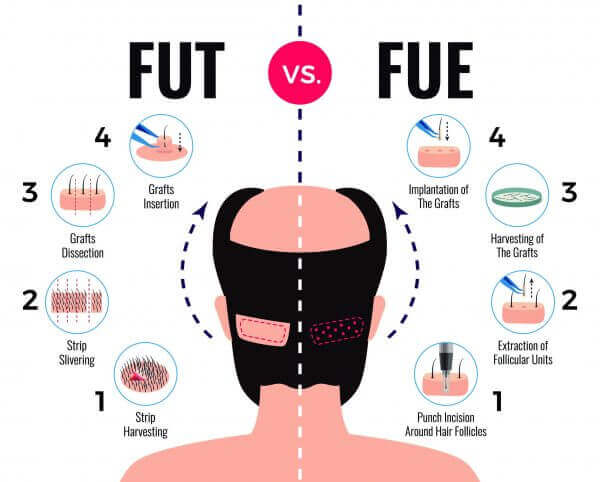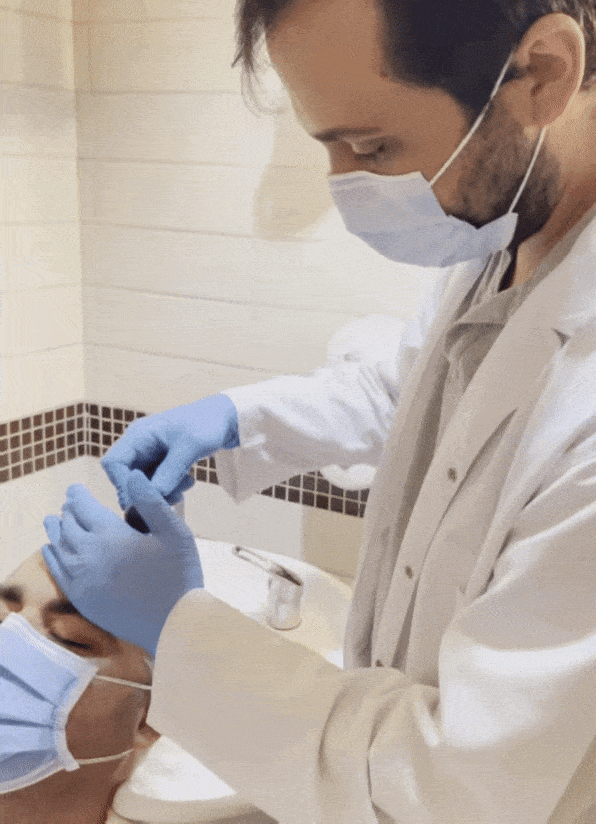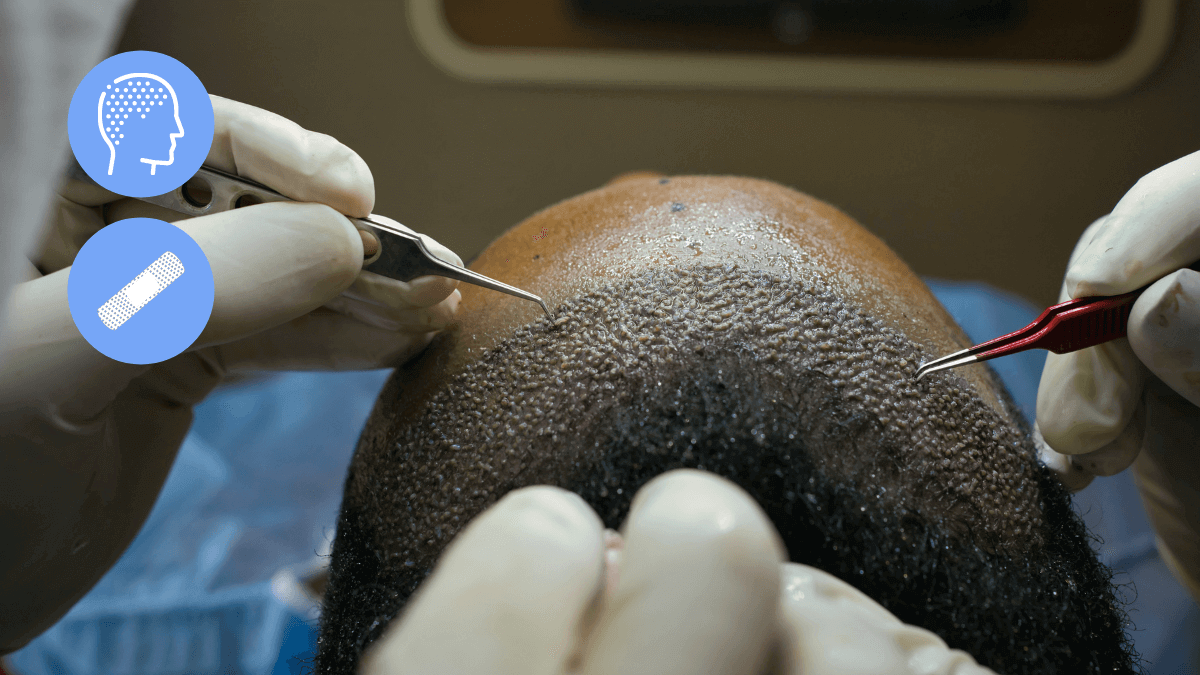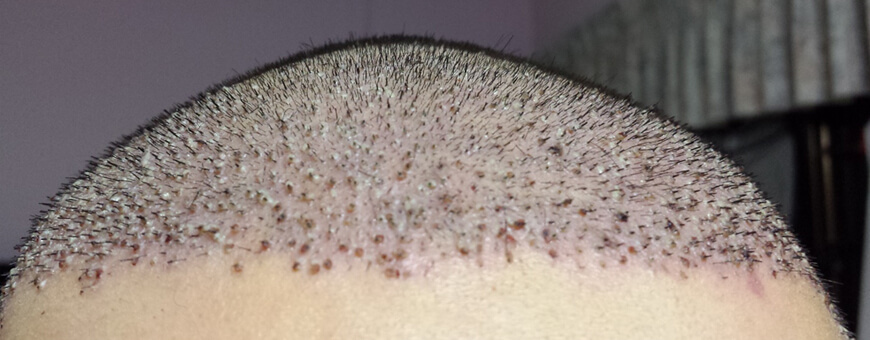For almost all hair transplant patients, scabs and crust can form mainly on the recipient area that used to be bald.
While this symptom is completely natural, some patients have a hard time figuring out what to do to get rid of them.
As a dermatologist doctor who specializes in hair transplants, I’ll explain why, when, and how they happen; and the steps you need to get rid of them.
TL;DR
▶ Scabs appear on the second or the third day that follows the hair transplant procedure.
▶ Scabs and crust form on your scalp because of the blood or edema from incision and extraction cuts made on your scalp.
▶ Under no condition should you scratch scabs or crust on your scalp, they need to be removed through healthier and softer methods if they don’t fall out.
▶ By massaging and washing your hair with the after-care products your clinic will provide you, you can soften and get rid of scabs and crust.
In this blog, we will explore:
Table of Contents
What is a Scab on the Scalp?
A couple of days following a hair transplant, for the majority of the patients, scabs and crust form primarily on the recipient area. These scabs on your scalp are the residue of the blood and edema that are released from the cuts and incisions made during the surgery.
They usually come in the form of millimetric scabs, one around every graft planted.
Are Scabs After a Hair Transplant Normal?
Yes, scabs are completely normal after a hair transplant and actually are a sign of healing.
Every patient will experience similar scabs on their scalp following the surgical procedure, although the intensity and the forming qualities will differ from patient to patient. Some might get very mild conditions with relatively less itching and get rid of the scabs easily while some patients can have hard scabs that stick around for a while.
But even the most extreme conditions are usually over within the first 14 days. It’s important to understand what exactly a scab formation is to relieve your doubts and fear:
How do Scabs form after a Hair Transplant?
During a hair transplant, numerous tiny incisions are made on your scalp both on the recipient and donor areas.
In FUE surgery, hair grafts are harvested individually from your donor area with an extraction tool, which causes millimetric wounds.
And if you’re getting FUT surgery, a relatively bigger amount of extraction is made in the form of linear tissue from the back of your scalp.
And in the plantation stage of the surgery for both FUT and FUE, each hair follicle is implanted either by making a small incision and then planting the graft, or by using a DHI pen and directly implanting the follicle in one step.

Millimetric (or not-so millimetric in the case of FUT) incisions are opened intentionally by your surgeon on both stages of your hair transplant. These incisions cause trauma on your scalp and a number of fluids can flow outside through these tiny openings as a reaction.
That’s how your body heals itself too.
Blood or edema are released from wound openings, when these liquids dry up as they get in contact with the outside, you’re left with crust or scabs that stay on the site of the wound. After a hair transplant, this process happens for every extraction or implantation wound on your scalp so hundreds of scabs form on it.
They can even be considered your ally since they secure your newly planted hair follicles in place during the most crucial part of your recovery.
Can I remove scabs after a Hair Transplant?
Yes, and no. It depends on when and how you want to remove them. You need to wait until they are ready to fall out by themselves and remove them by softly massaging them; you shouldn’t scratch your scalp right when the scabs have formed.
It’s just like a wound that you would get after falling as a kid, and your parents would tell you not to pick the crust/scab. Spoiler alert: It would always get worse because once you removed them immaturely, the wound would bleed again.
Instead, they would become softer and itch less as they healed, and when you finally removed them after waiting, you would see your skin healed underneath it. It’s the same as the scabs following a hair transplant.
You can displace grafts or make them fall out with the scabs, which would certainly affect your hair transplant success.
And, if you start picking your scabs and the crust, you can risk developing an infection on your scalp.
You have to let them heal, and when the time comes, you should carefully remove them the correct way.
But what is the correct way?
How Do I Get Rid of Scabs on My Scalp After a Hair Transplant?
Scabs after hair transplant can be really itchy and disturbing, just lying there waiting to be picked.
It’s not uncommon for patients to obsess over their scabs. As a dermatologist, I’ve treated many patients with skin problems that worsened because they wouldn’t let it go.
In the case of scabs, we advise you to wait at least a week before even touching your scalp, and remove the scabs in the way I’ll suggest:
Scab removal after a Hair Transplant
The top three allies you have in removing the scabs on your scalp following a hair transplant are 1) mild shampoo, 2) soft and warm water, and 3) soft massaging.
If you regularly combine these three practices starting from the 4th day of the surgery, you’ll get rid of the hair transplant scabs very soon.

Here’s how exactly you should do it:
1️⃣ Get your hands on a mild shampoo, clinics such as UnitedCare provide patients with aftercare packages and all the instructions and information on using them. These sorts of shampoos put the least amount of stress on your hair follicles while helping keep your scalp clean.
2️⃣ Get under a warm and soft stream of water. The water intensity and heat shouldn’t put your scalp under any stress, so you might need to adjust.
If your showerhead can’t be adjusted to soft, you can use a cup to wash just your scalp and adjust the intensity by hand.
3️⃣ Using the shampoo and the warmth of the water, gently massage your scalp, especially in the recipient area. Make sure your nails aren’t involved and you’re using your fingertips only; remember, you’re trying to soften up the scabs, not to pick them up.
What to do if your scabs don’t fall out
If the scabs are still there 10 days after the surgery, and they don’t seem to be healing, consult your dermatologist.
If you get your hair restoration surgery done at attentive hair clinics such as UnitedCare, you won’t have to reach out to us, simply because we already set up constant checkups during the recovery phase of every patient.
Get Your Hair Transplant Done Right
Even though most patients naturally recover after a hair transplant surgery without any errors and problems, the success is not certain.
You can lose your transplanted hair, your scalp can form excessive crusting that leads to hair transplant infections, which can lead to life-threatening situations.
Hair loss is a medical condition that should be treated by a medical expert.
At UnitedCare, we embrace a holistic approach to hair transplantation, to help you live a worry-free life from hair loss.
We promise success with expert dermatologist surgeons, top-of-the-line hair transplant techniques and technologies, and attentive care until success.

We’re just one click away: 👇
Not worrying about crabs after the surgery is a possible option with the right clinic.
You can get a free consultation from UnitedCare’s expert dermatologists right now to achieve it:
Frequently Asked Questions (FAQs)
When can I touch my transplanted hair?
You can touch your transplanted hair after the first week of your surgery, once the initial healing process ends. If you touch your hair earlier, you can risk your planted grafts falling out or even developing a scalp infection.
How do you soften scabs after hair transplant?
Hair transplant scabs can be softened by massaging your scalp using the mild shampoo your clinic provides you under a warm and soft stream of water.
What is a Crust in hair transplant?
Crust and scabs form at the incision sites on your scalp that are made during graft extraction and plantation. A crust actually is a good sign, meaning the wounds caused by the trauma of incisions have healed.


